10 Cheap Coupes with 300+ hp
We love breaking down data in different ways here at Insider. Recently, we decided to look at value through a different lens: cost per horsepower. A healthy discussion ensued, with many of you sharing that you’d gladly pay a little extra for a trimmer body style, a high-performance package, or a V-8.
To our lengthy spreadsheets we returned, playing with the filters to yield a fresh list. This time, we set the threshold at 300 hp and looked only at two-door models. To keep the selection affordable, we restricted ourselves to cars that cost no more than $15,000. We didn’t want to just be talking about rough examples, either, so all values you see here are for vehicles in #3 condition—well-maintained, driver-quality cars, in other words.
The choices vary wildly across the decades. First off, no car in the Hagerty Price Guide from the ’80s meets these criteria. Sports cars with 300 horsepower existed in the ’80s, of course, but none are cheap, as defined here. The same is true for the 2010s: Powerful two-doors abound (hello, C7 Stingray), but they’re well into the $30,000 range. We had to head back to 2010 and Ford’s Mustang (315 hp, $13,600) to meet each of our thresholds. A smattering of foreign cars from the ’90s and ’00s fit our filters, but none show up in any prior decade. Together with how expensive ’80s cars have become, this won’t surprise any good student of automotive history.
In general, you’ll find the richest selection of two-door classics with 300 or more hp in the 1960s or in the 1990s through the 2000s. To make sure no decade is under-represented, we’ve chosen two from each decade—excluding the ’80s, for the reasons listed above.
Without further ado, here are 10 affordable two-doors, most of them with V-8s, and all with 300 or more hp.
2005 Ford Mustang GT
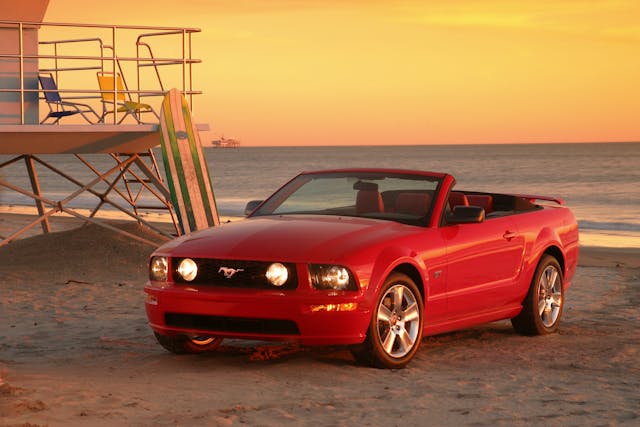
Horsepower: 300
#3 value: $14,800 (convertible)
Mustangs from the S197 generation, especially those that predate the 2010 facelift, are some of the most accessible ways into 300+ horsepower. Even better, both the coupe and convertible variants of the GT model (the entry-level V-8) can be found for under $15K: Droptops are just a skosh under that figure, but the coupes from 2005–09 are only $12,600 in #3 condition. The V-8 got you a host of upgrades from the base V-6 car, plus the glorious exhaust note that’s worth the price of admission in and of itself.
2008 Nissan 350Z Roadster
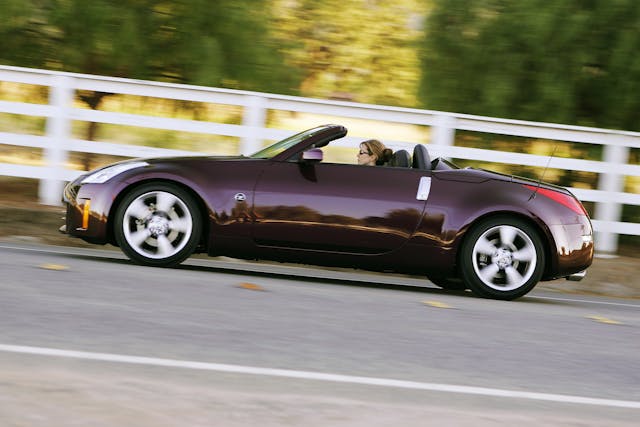
Horsepower: 306
#3 value: $11,600 (Base)
Bucking the usual trend of coupe versus convertibles, the soft-top version of Nissan’s 350Z is the one that’s more affordable. Horsepower varies across the model years, and even among the trim levels until 2007, when Nissan decided to put the same 306-hp variant of its VQ-series V-6 in all of the cars. Redline increased by 500 rpm, to 7500, and fuel economy ticked up, as well. The only downside is the additional cost of the performance goodies: If you want the limited-slip diff, stability control, or cruise control, set aside another two grand and look for the Enthusiast trim. But if you want simple, top-down sporting fun? The base 350Z is your champ.
1999 Chevrolet Camaro Z/28 Coupe
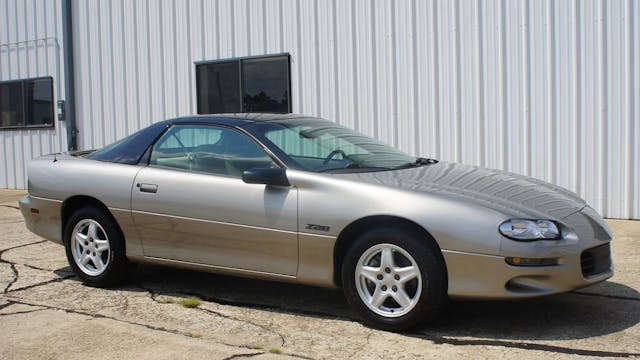
Horsepower: 305
#3 condition value: $12,400
The fourth-gen Camaro follows the general rule that when the top goes down, the price goes up. If you’re on a budget, you can work this to your advantage: a 1999 Z/28 coupe with a manual transmission and the 5.7-liter, 305-hp LS1 goes for $12,400, while the droptop is $20K. (Those who know these cars agree that 305 hp is quite conservative.) This model year also marked the arrival of a Torsen diff for the Z/28 model. Though it ultimately went away after 2002 because of a new head-impact crash standard, the F-body Camaro Z/28 is a stylish, modern, and affordable avenue into the legendary nameplate.
1998 Mercedes-Benz SL500 Roadster

Horsepower: 315
#3 price: $14,800
It’s hard to imagine a stronger contrast between the two foreign-make cars on this list, though both are roadsters. As we noted in our buyer’s guide for this generation (R129) of SL, this luxurious, over-engineered German roadster hails from the cost-is-no-option era of Mercedes-Benz product development. Both elaborate and stout, this 315-hp, V-8-powered droptop is a ton of car for $14,800. This model year is a bit of a sweet spot: Just two years prior, that M119 engine received individual ignition coils, lighter pistons, and a five- rather than a four-speed automatic. A year later in 1999, Mercedes swapped the M119 for the M113, a single- rather than dual-overhead cam V-8 that made 13 fewer horsepower.
1970 Mercury Marauder
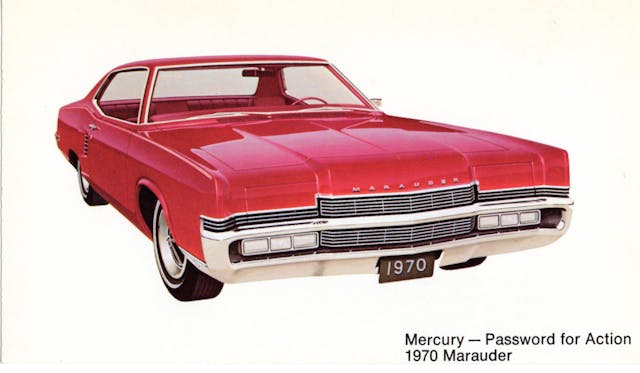
Horsepower: 360
#3 condition value: $13,600
Unlike many of the cars on this list, the ’71 Marauder doesn’t require you to give up its highest-spec engine to stay under fifteen grand. Marauders equipped with the 429-cubic-inch, 360-hp Cobra Jet cost just $13,600 today, and even those with the X-100 package are just $15,200. (Ticking that box added a host of options: automatic transmission, rear fender skirts, two-tone paint, leather upholstery, and alloy wheels.) Dripping with power and luxury, this personal luxury coupe nonetheless didn’t sell that well, but that just means if you show up at a car show with one today, there probably won’t be anything else like it.
1971 Pontiac Grand Prix
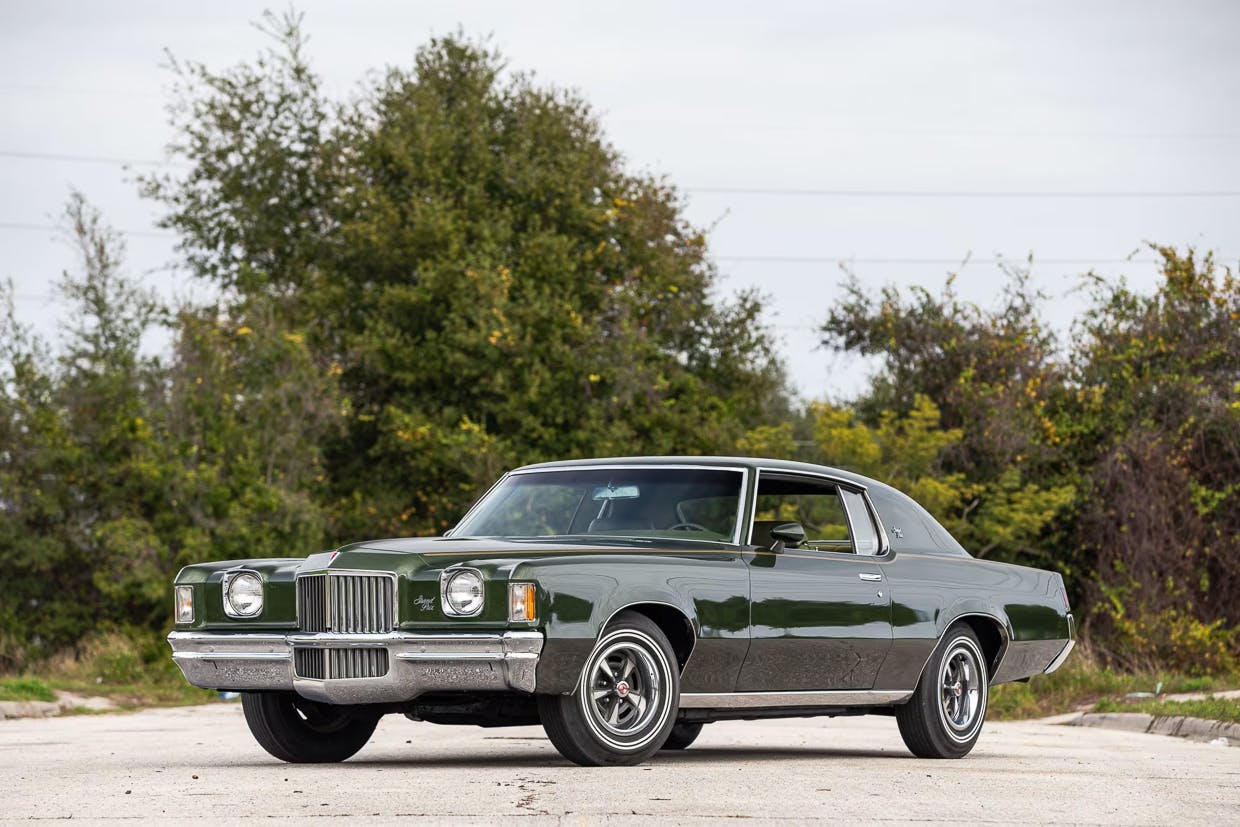
Horsepower: 300
#3 condition value: $14,300
If you dig the ’71 Grand Prix, you don’t just like beak—you like boattail, too. Though not as dramatic as Buick’s Riviera of the same period, Pontiac added the distinctively molded rear deck lid to its personal luxury coupe in ’71. As has been well-told, the ’70s weren’t the best time for big power numbers. Compression began dropping after 1970, the industry method for calculating horsepower changing from gross to net in 1972, and the one-two punch of emissions regulations and fuel crisis impact all conspire to explain why all of the sub-$15K, 300+ horsepower cars from this decade hail from 1970 or 1971.
The best deal for the most powerful Grand Prix is the higher tune of the standard, 400-cubic-inch engine, which squeaks into this list with 300 hp. The 455 was reduced from 370 to 350 hp for ’71, and costs over twice as much today: $32,000 for an example in #3 condition.
1965–69 Avanti II
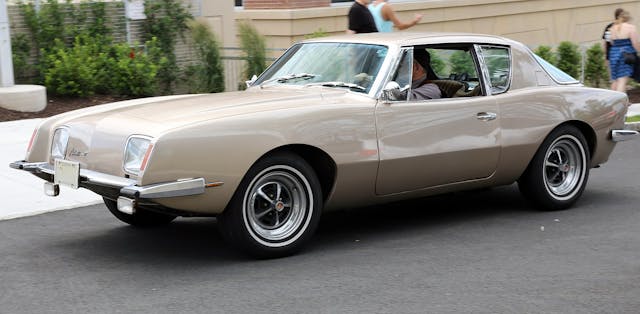
Horsepower: 300
#3 condition value: $13,000
Looking for something powerful but off-beat? Check out the funky fiberglass Avanti II, designed by Studebaker and powered by a Chevy 327 V-8. Available in a wild array of colors, both inside and out, the Avanti II (1965–69) is surprisingly affordable for such an oddball. Values are essentially flat across the production years: a ’65–67 model carries a value just $200 higher than its ’68–69 brethren. These Avantis, produced after original maker Studebaker closed its factory in ’63, reached production thanks to a pair of car dealers from the brand’s home town of South Bend, Indiana, who bought production rights to the model name and a bunch of spare parts.
You’ll pay another 10 percent on top of the Avanti’s #3 value for factory air conditioning or a four-speed … but since that value is $13,000, you’re still under $15K with one or the other desirable add-on.
1968 Oldsmobile Delta 88 Holiday Coupe

Horsepower: 310
#3 condition value: $11,300
Offered across 50 years, the 88 was the top-selling Oldsmobile in the ’50s and the ’60s. As of the 1967 model year, the 88 received a facelift, adding more beak and more fender flare. The following year ushered in some subtle but elegant changes: the center section of the grille was changed to body color, and the turn signals were no longer squeezed in between each pair of round headlamps. The 1968 model year was the last that “Delta” would denote a trim level on the 88; afterward, it was absorbed into the name of the model.
The 88 may not be as coveted as other names of full-sized ’60s performance—Chevrolet’s Impala SS, Ford’s Galaxie—but the ’68 year in particular is one of the best deals for a handsome, powerful muscle car, especially if you forgo the convertible and its $4000 premium: The 425-cubic-inch V-8 made way for a 455-cubic inch mill, adding 10 horsepower, for a total of 310.
1959 Lincoln Premiere Coupe
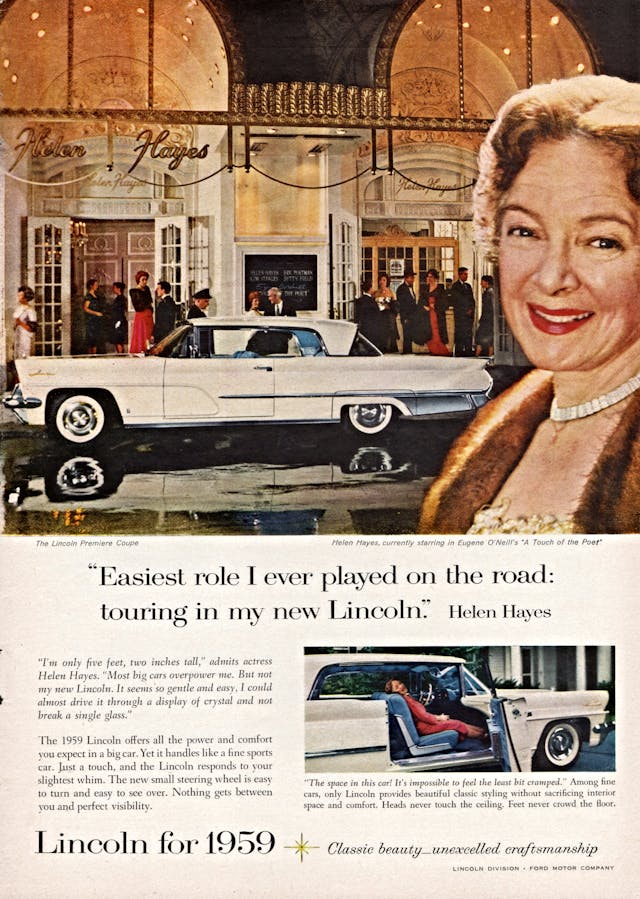
Horsepower: 350
#3 condition value: $13,700
Totally new for 1958, with unibody construction, the Lincoln Premiere immediately established itself as large and in charge—not only in luxurious appointments and overall footprint, but in engine displacement: Both the ’58 and ’59 model years were powered by a 430-cubic-inch V-8, though power dropped from 375 to 350 hp as of 1959. Hardtop sedans were the most popular, and those from ’58 and ’59 both qualify for this list, with #3 values of $13,700 and $12,000, respectively. We’d dare to say that the Thunderbird below, with its separate grille and headlights, looks a bit more modern: But if you want the most luxurious car made by Ford in the ’50s—and if your budget doesn’t stretch to a Continental Mark II—there is no substitute for the Premiere.
1959 Ford Thunderbird Coupe
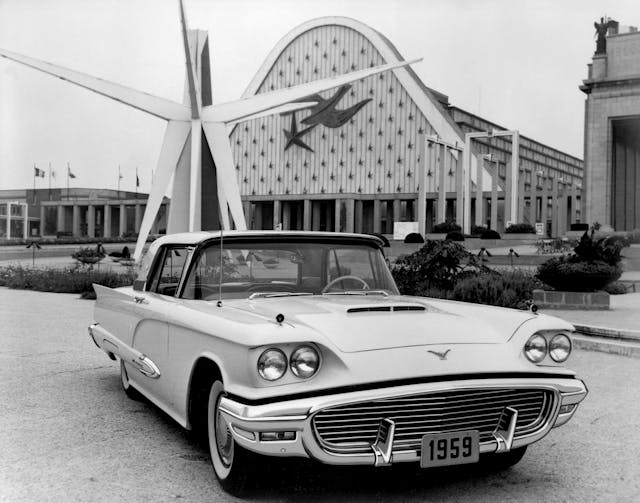
Horsepower: 300
#3 condition value: $13,900
If you’re looking for ’50s glamour and a recognizable model name, the second-gen Thunderbird offers a lot of bang for your buck … especially when you consider that the 1959 coupe is nearly $12K cheaper than the convertible, even when both are equipped with the 352-cu-in engine. Touted in a 1959 brochure as the “newest” version of Ford’s “famous Thunderbird V-8,” this four-barrel powerplant from the FE family was the second-largest engine available for 1959, which saw the introduction of the 430-cu-in MEL V-8. If you’re a big fan of the MEL—we are—consider adding $700 to your budget and buying a ’59 coupe with that engine: You’ll gain an extra 50 hp.
If you’re strict about your $15K budget, however, you may need to do without A/C: The factory-installed option carries a 10 percent premium in our price guide, and even if you go the modern route, and shop the Vintage Air catalog, you’re still looking at $1900 before labor.
***
Want a better understanding of what’s driving collector car values? Sign up for the Hagerty Insider newsletter.



If old horsepower rating Tbirds make the list any GM product from the 90s with the “detuned Corvette LT-1 engine” in it should be considered. 1994-96 Caprice 9C1 5.7 L V8 and some Roadmasters for example. I get that the SS Impalas will be too pricey for this article.
Those engines stock have to make more power than a stock 50s Tbird engine… and if mods count, well just “retune” the detune to Vette specs and you are factory rated 300 HP using the modern measures.
perhaps there’s a future riff on this same list, but for sedans / wagons???
^Your right, the Caprice coupes ended in the boxy generation.
Not sure if you could get the Police package on the coupes then (77-90), or if it would hit the “300 HP” mark.
Sad not to see the Oldsmobile W-30’s on this list.
No 300+ hp W30s (’72 and earlier) for under 15k. Not even a basket case unfortunately…
You do know what a coupe is, right?
I’m not sure the author of this piece does! Weird, huh?
Hair for bald people, right?
Seems we got stuck with another “Click bait” ….
These are coupes the GM cars you mentioned all have 4 doors.
My original owner 93 base coupe is rated at 300hp and 340 ft lb from the factory. Even with 163000 miles I wouldn’t sell it for 10k.
A lot of those prices seem rather low given what I have seen for the same
cars over the past couple years. As for 300+ HP coupes that are tough and
reasonable, how about the Infiniti G35, G37 and Q60 (2014 – 2015)?
Many are in nice condition with reasonably low milage and under $20,000.
The IPL versions and the S versions with manual shift are the most sought after.
Weren’t those all 4-door cars? That would have struck them from the list right from the top.
The GP is going for twice that in good condition. Most are around $25k or more depending on the options.
Never saw a good Avanti that cheap.
The Benz has tons of electrical and other mechanical issues.
Late C4 models are the best bet for cheap power.
So true. These prices are WAAAY OFF Hagerty!!
No, they are not! They are market averages. The prices YOU see are way off.
You’re probably right. People can ask whatever they want. These are reported sale prices.
I drooled over the 69 Grand Prix in the showroom, when a new model J was $4800. Canadian, and my annual salary was no more than that. Three years later, I settled for a used 69 Grande Parisienne, which a co-worker nicely referred to as a GP. That’s as close as I ever got. I still sure like the looks of them, but the 71 looks best to me.
I had a ’70 GP SJ, 400 4v, turbo 400, dual exhaust, bucket seats….great car. sold it to my BIL, kept the ’69 Mustang GT convertible I had at the same time. Still have it, and the girl that I gave a ride in it, 45 years later, still my wife.
Yeah, stepdad had a new one, Benz was just a great car until service time- or something/anything went wrong. Then, well, a mid six figures income came in handy. And not really the kind of thing even a skilled enthusiast can just jump in and fix. Just like other Euro cars (looking at you, Jag) no such thing as an affordable Benz.
I suspect you are right about the Benz. The owner and CEO of the company I worked for at that time had a new one that he always parked in the handicapped spot (‘My company, I park where I want’). I remember walking by his office one day and overhearing a phone conversation he was having with the dealer about an electrical issue. ‘No, it is NOT the battery g-dammit! I know what I’m talking about!
While the Squarebird isn’t as popular as the two seater or Bulletbird, + $ 700 for the MEL seems a little on the light side with only about 9000 430 equipped being produced. I very rarely see them and then when you consider how many are left. Maybe just my experience but I would think for its fans a desirable option that would bring a bit more coin if you find one.
Surprised, but not surprised that the Cadillac CTS coupe isn’t on the list somewhere. 320hp V6, decent examples can be found well under 15k.
Agreed
Any horsepower rating before 1971 is gross, not net horsepower as all were rated after 1971. I am very suspicious of early horsepower ratings. And everybody forgets those numbers are inflated, and probably overstated as well. Modern 300 horse (net) are probably 375-395 gross.
Horsepower is relative to where you measure it. Measured off the flywheel w/o the tranny attached will be approx 10% higher than measuring the output with transmission. So the terms gross and net are misleading unless the above is how you’ve calculated the hp.
The difference between gross and net hp, as I understand it, is that gross was measured on an engine bereft of any accessories and not even exhaust manifolds. Net was measured with all that junk on the engine, basically how it would be equipped in the car. I think that is generally referred to as flywheel horsepower (fwhp). The real measure is, of course, is rear wheel horsepower (rwhp). How much you’re putting on the pavement. That even compensates for if you’re running drag radials, slicks or stock street tires like I did.
Incorrect points. Take a read here…
https://ateupwithmotor.com/terms-technology-definitions/gross-versus-net-horsepower/
Gross measurements were made on engines running open headers, timing optimized, no air cleaners, and no accessories being driven by belts on engine…
Step away from the keyboard….. Ken had the theory correct, you just used article with more words to say essentially the exact same thing. KEN nailed it with RWHP!
Quote: Let’s clear up a couple of common misconceptions about gross and net horsepower ratings:
Contrary to some assumptions, net horsepower ratings DO NOT measure horsepower at the drive wheels. Both gross and net ratings are at the flywheel and do not reflect power losses in the drivetrain.
P.S. your ‘incorrect’ was wrong. Play nice, make your mama proud.
In 2004 bought a ’69 Corvette 427 L-36 that was rated by Chevrolet at 390 gross hp. The car had an M21 4 speed and 3.36 gears. At the same time I had a 2000 Z/28 Camaro (identical to the one in the article except mine had the factory ground effect and spoiler kit) that Chevy rated at 305 net hp. That car had a 4 speed automatic and 2.73 gears. When I bought the Vette it came with three boxes of documentation, including an article from the day of an identically equipped car. It said it ran a 15.02 @ 92 mph in the quarter mile. I never took this numbers matching, unmolested car to the drag strip but it was pretty ho-hum on the street. A head turner in its LeMans Blue livery with that big block rumble. On the other hand, my 305 “net” horsepower relatively stock Camaro LS1 pulled 318 rwhp on a chasis dyno and ran a best 13.44 @ 107.43 mph. The car was a blast to drive and it proves that Chevrolet wasn’t using the same formula in 1969. I now have a 2009 Vette with the LS3, an LS1 derivative, that is rated at 430 hp. The magazines of the day claimed that it could run the quarter in 12.45 sec. I’m too old to be running the quarter mile anymore, so I’ve never verified that.
Too old to run a 1/4?
Takes exceptionally good reflexes to 1/4 mile a car at peak. I’ve had the displeasure of watching my reaction time and 60′ time increase since my early 50s. At 64, I no longer compete seriously, but will do display and demo runs for the fans and fun.
Detroit played with the horsepower ratings in the 60’s to satisfy either the buying public (over rated), the insurance companies (under rated) or NASCAR and NHRA regulations (who knows?). The Ford 428 SCJ was rated at 335 hp in 1969 when it was introduced in the Mustang. It is commonly believed that it was actually pumping out about 100 hp more than that. The bad news is that they still do in the 21st century. I had a 2000 Z/28 with an LS1 engine that was rated at 305 hp. That car, with only a cloth air cleaner element, pulled 318 rwhp on a chassis dyno. Even accepting the 10% negative impact of my automatic transmission, that would put fwhp at around 353 hp. Chevy was marketing the same engine in the Corvette at the time, rating it at 345 hp. They attributed the difference between the Camaro output and the Corvette output to exhaust systems. B.S.! They didn’t want to piss off the Corvette buyers whose cars cost nearly twice as much.
The 60’s cars and “300hp” are on paper only. If all you want is the number, then yes they have 300hp, but a later car with only 250hp like an early C4 Corvette as mentioned is a more powerful choice. The gross hp numbers just don’t hold up to the later decades. Though they have plenty of torque!
All of those 60s or 70s cars at that price level will have had their engines trashed by now!
To muddy the waters even more ( and why not ) besides the switch from gross to net you had the introduction of voluntary SAE ‘Certified’ HP numbers in 2005 to keep manufacturers ratings comparable.
Hard to believe you left out the 92 and later Corvettes. Cheapest 300 horsepower on the street. Easily available for 7000 and up depending on condition and year. Fun cars to drive.
Here here, Roy. My 94 Triple Black Vette Convertible is rated @ 300 HP. 6 speed manual. So much fun to drive, especially for the $14,500 price tag. 30K miles, all original is way-fun for me! When I read the article headline, I thought the car would b #1 or 2 on the list. The early C4’s had some problems, but by early to mid 90’s, Chevy had it dialed in. Love mine!
Bought a 40th Anniversary ’04 GTO from a farm estate auction for $8900. The interior was seam split from years of neglect, but the original LS1/Tremec 6spd @69,000mi were fine after belt/fluid/lube change, and the tires replaced to drive. I am given to understand these were rated at 1hp/insq; that’s 349hp for a 5.7. I doubt a better interior would have added $6100 to the value/selling price. I suspect that the final price was more determined by the majority of bidders were “Oles and Svens” (auction in SW MN) and had zero clue what the car was, a TorRed Holden Monaro with the steering swapped to the left. Love it, will keep til death. The new Blueprint 7.0 etc adds some spice!
My first car was a 1972 Delta 88 with the 455. Bought it for $820. Didn’t realize it had so much horsepower
You left off the 2003 Mercedes SL500. At 302 hp and $14,900 for a condition 3 (I just looked it up) it meets your criteria, and it is a convertible
By ’72 the 455 was a lower compression, different heads-detuned for smog motor vs. the ’69, so that would keep it off this list Even with a Gross hp rating
i think you missed a big one, only because they can be had for well under $10K.
The 2011 Ford Mustang V6 is only ten horsepower shy of last year’s Mustang GT and is the only vehicle in its class equipped with more than 300 horsepower to net over 30 mpg. The Mustang V6’s new engine is a 3.7-liter V6 that produces 305 horsepower at 6,500 rpm and 280 pound-feet of torque at 4,250.
Colin Chapman said [ more or less] “Less weight-more horse power” [per cu in].
How about the Maserati Coupe/GranSport? These have almost 400hp, and are unbelievably good value for money these days for $10k-25k. A lovely, sleek Giugiaro design, 4.2 litre Ferrari derived F136 V8 that makes a divine sound, and pretty good handling. Absolute bargain I’d say
Til it inevitably needs repairs or serviced.
Glad to see the Grand Prix on the list. My brother in law should have know better then loaned me his 1969 428SJ positraction brown with black vinyl top and full hub caps . It was a real sleeper. It surprised a few muscle cars in street race on Saturday nights. This was summer of 1970 fresh out of high school and driving my 62 chevy with the blue flame 6. I thought I was on top of the world.
You were on top of the world. Those were great times and now are gone forever–never to return. In the late 60s, I would sneak my dad’s Cadillacs out of the garage and race some of the guys. Getting off the line was a problem but I did well on the top end. Today I think back to the problems I might have had if I had blown the engine or broken a universal joint on the drive train.
You missed the C4 1985 Corvette.. 350 CU. IN…
AMEN!!! A well maintained ’85 C4 is lots of fun and enjoyable for sure!!!
The 1985 C4 didn’t have 300 hp (the L98 engine only made 230 hp in ’85). Not until the LT1 debuted in the 1992 Corvette did hp reach 300.
AMEN!!! A well maintained ’85 C4 is fun and enjoyable!!! Keep Driving!!!
The 2006-2009 Jaguar XK’s could also be added to this list, as you can routinely find those for under $15K. 300HP and a classy-looking ride. You can sometimes even find the ones with the newer 5.0 V8’s with 385HP right around the $15K mark.
Absolutely agree, the jags of that period are a incredible value, my 5.0. jag was a ball to drive and very dependable.
My 98 xjr has 370 hp n runs 5.0 0-60 n top end 156! DB7 suspension n Benz 5 spd- fastest sedan in 1998- faster than a base 911 n matched Ferraris
Underrated seriously- these mostly go under $15k.
More like the DB7 has Jag / Ford suspension. As to the comparison against a 911, guess you have never driven one. Once you own one you’ll always “need” one.
A 2005 XKR supercharged 4.2 coupe with 390 HP is also a bargain. It’s the last XK with the body reminiscent of the E-type and was manufactured when Ford owned Jaguar. It has few of the “gremlins” for which Jags were renowned and is relatively easy to work on.